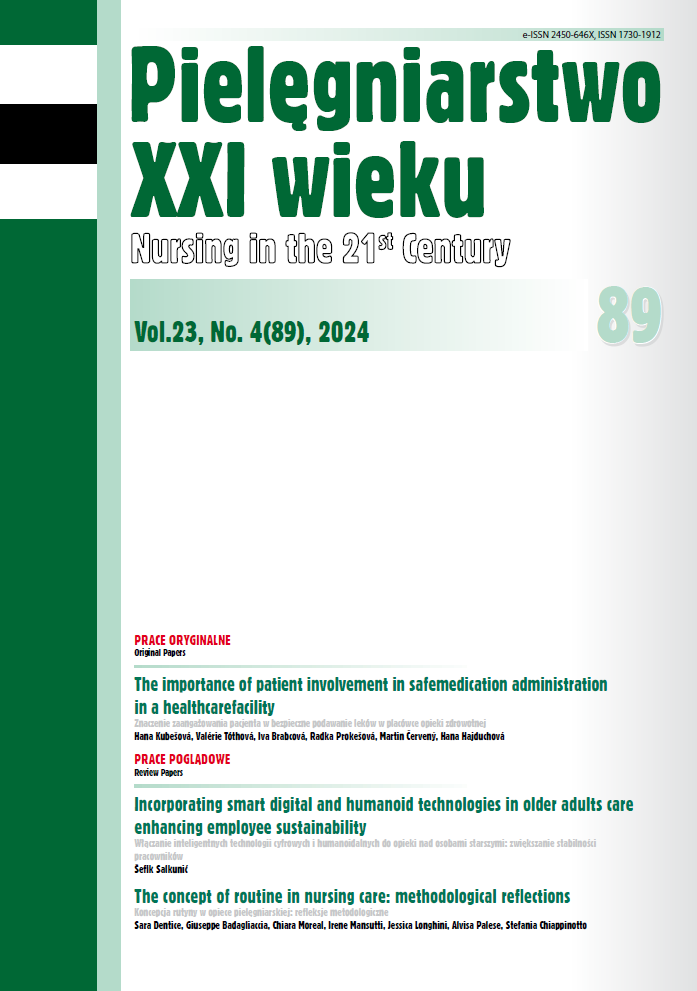The impact of early mobilization through a tele-education program on health condition of mothers after caesarean section
DOI:
https://doi.org/10.2478/pielxxiw-2024-0041Keywords:
health, telenursing, exercise, gynaecologyAbstract
THE IMPACT OF EARLY MOBILIZATION THROUGH A TELE-EDUCATION PROGRAM ON HEALTH CONDITION OF MOTHERS AFTER CAESAREAN SECTION
Aim. Nurses can provide remote nursing care without the patient being physically present in a clinical setting, especially in the areas of tele-education, counselling, and telemonitoring. The goal was to create and implement the tele-education program of physical activity for mothers after a caesarean section and analyse its impact on their physical condition.
Material and methods. The sample consisted of 411 participants with an average age of 31 years old. It was a quasi-experiment. To evaluate the effect of the tele-education program a self-constructed questionnaire was used. Data were processed using the
Chi-square test and Cramer’s V.
Results. Statistically significant relationships were found between participation in the tele-education program and better physical condition of mothers after a caesarean section, specifically in terms of pain occurrence, wound healing, and gastrointestinal comfort.
Conclusions. The findings indicate the benefits of tele-education in gynaecological-obstetric nursing, suggesting that the development of telenursing is desirable and can contribute to increasing its accessibility, thereby affecting the quality of nursing care and satisfaction of mothers post-caesarean section.
References
1. Dosedla E, Calda P. Morbidita súvisiaca s cisárskym rezom – prospektívna kohortová štúdia (Morbidity Associated with Caesarean Section – A Prospective Cohort Study) Actual. Gyn. 2015;7:40-41.
2. Janek Ľ, Borošová M, Sojáková M. Prevencia niektorých závažných pôrodníckych komplikácií u žien po cisárskom reze v anamnéze. Gynekológia pre prax (Prevention of Certain Serious Obstetric Complications in Women after Caesarean Section. Gynecology in Practice), 2016; 4 (2):193-198.
3. Reisinger-Kindle K, Qasba N, Cayton C, et al. Evaluation of rapid telehealth implementation for prenatal and postpartum care visits during the COVID‐19 pandemic in an academic clinic in Springfield, Massachusetts, United States of America. Health Science Reports. 2021; (4)4: 455.
4. Bashir A, Bastola DR. Perspectives of nurses toward telehealth efficacy and quality of health care: pilot study. JMIR Medical Informatics. 2018; 6(2): 556-563.
5. Balenton N, Chiappelli F. Telenursing: bioinformation cornerstone in healthcare for the 21st century. Bioinformation. 2017; 13(12): 412-414.
6. Bowden SJ, Dooley W, Hanrahan J, et al. Fast-track pathway for elective caesarean section: a quality improvement initiative to promote day 1 discharge. BMJ open quality. 2019; 8(2):e000465. https://doi.org/10.1136/bmjoq-2018-000465.
7. Chen Y, Wan J, Zhu Z, et al. Embedding evidence of early postoperative off-bed activities and rehabilitation in a real clinical setting in China: an interrupted time-series study. BMC nursing. 2022; 21(1): 98. https://doi.org/10.1186/s12912-022-00883-5.
8. Paton F, Chambers D, Wilson P, et al. Initiatives to reduce length of stay in acute hospital settings: a rapid synthesis of evidence relating to enhanced recovery programmes. NIHR Journals Library. 2014.
9. Hájek Z, et al. Porodnictví. Praha: Grada Publishing; 2014, p. 576.
10. Kleiman AM, et al. Evaluation of the impact of enhanced recovery after surgery protocol implementation on maternal outcomes following elective cesarean delivery. Int. J. Obstet. Anesth. 2020; (43): 39-46.
11. Laronche A, Popescu L, Benhamou D. An enhanced recovery programme after caesarean delivery increases maternal satisfaction and improves maternal–neonatal bonding: a case control study. European. Journal of Obstetrics
12. & Gynecology and Reproductive Biology. 2017; (210)4: 212-216.
13. Maryam A, Fariba A, Azita M, et al. The effects of auriculotherapy on shoulder pain after a cesarean section. J. Acupunct. Meridian Stud. 2020; 13(5): 157-162.
14. Weerasinghe K, Mohamed R, Subhani B, et al. Physiotherapy training and education prior to elective Caesarean section and its impact on post-natal quality of life:
15. a secondary analysis of a randomized controlled trial. BMC research notes. 2023; 16(1): 270.
16. Gilbert I, Gaudreault N, Gaboury I. Exploring the effects of standardized soft tissue mobili-zation on the viscoelastic properties, pressure pain thresholds, and tactile pressure thresh-olds of the cesarean section scar. J. Integr. Complement. Med. 2022; 28(4): 355-362.
17. Macones GA, et al. Guidelines for postoperative care in cesarean delivery: Enhanced Re-covery After Surgery (ERAS) Society recommendations (part 3). Am. J. Obstet. Gynecol. 2019; 221(3): 247-249.
18. Liebergall-Wischnitzer M, Shaphir A, Solnica A, et al. Are Paula method exercises effective for gastrointestinal reactivation post-elective cesarean delivery? Randomized controlled trial. J. Adv. Nurs. 2021; 77(4): 2026-2032.
Downloads
Published
Issue
Section
License
Copyright (c) 2024 Authors

This work is licensed under a Creative Commons Attribution 4.0 International License.




